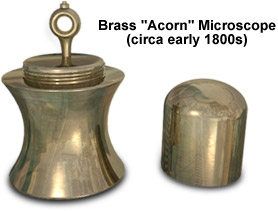Brass "Acorn" Microscope
Totally encapsulated in a cylindrical case, this early nineteenth century compact microscope was crafted to easily fit into a pocket, and is known as the Acorn microscope. The model featured below was redrawn from photographs of the original microscope, which is part of the Billings microscope collection at Walter Reed Army Hospital in Washington DC.

The pocket-sized instrument surprisingly functions as a compound as well as a simple microscope. A small brass cylinder housing encases the compound monocular microscope and is comprised of several sections. At the bottom end of the cylinder, a screw cap attaches to form the base and is designed as a compartment to hold specimens for observation. Embodied within the cylinder is an elongated cone-shaped structure that contains an eye lens and a field lens. When in use, the conical moiety must be placed in reverse position or upside down. A screw cap attaches to the upper section of the cylinder and serves to protect the bi-convex lens. The simple microscope is comprised of a stem that bears an object pin and lens, which protrude from the upper screw cap. The rounded dome-like cover measures three quarters of an inch in diameter. Signed by T. Harris, this unique pocket instrument was produced in London, England.
BACK TO NINETEENTH CENTURY MICROSCOPES
